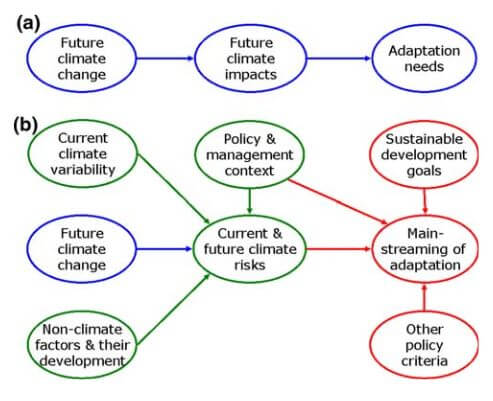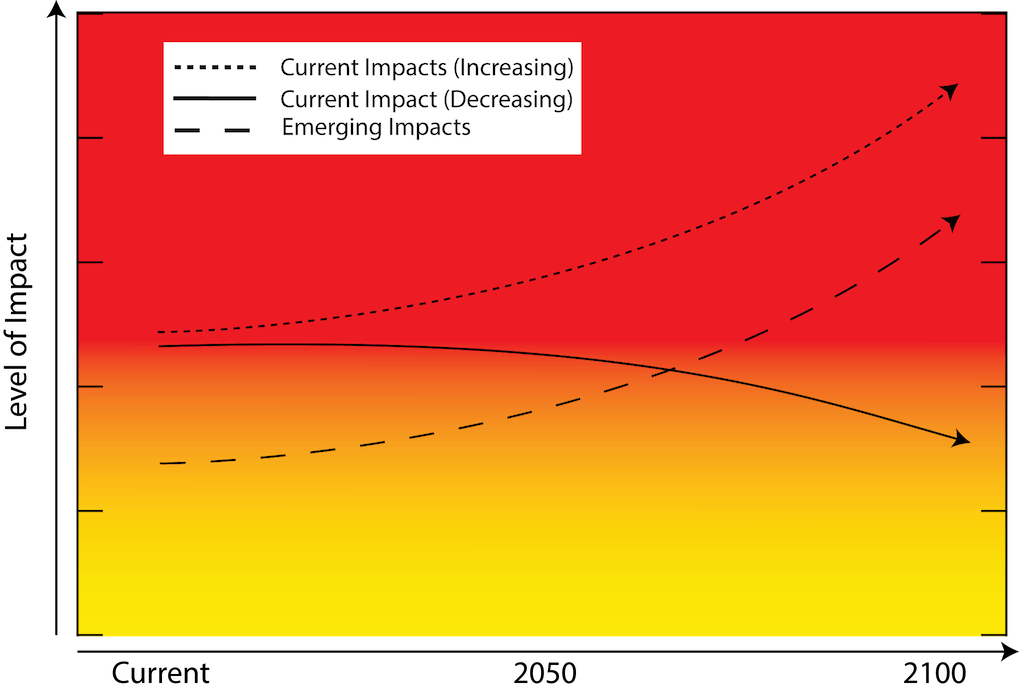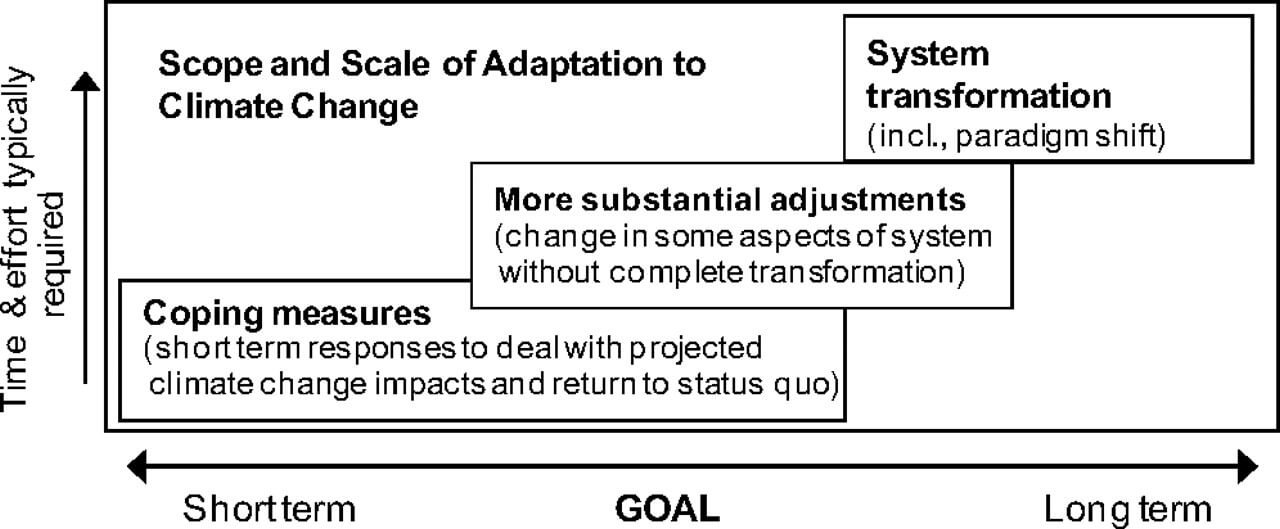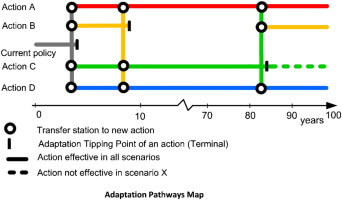How to adapt
Key information
To best adapt to the consequences of current and future climate change, we must now begin to develop and implement proactive strategies for adaptation. Currently, some adaptation is occurring, albeit on a limited basis. However, as the impacts of climate change are expected to increase with increasing global temperatures, the options for successful adaptation diminish and the associated costs increase with increasing climate change.
- Policy-based approaches to adaptation are becoming increasingly popular as they consider current and future climate risk and recommendations for adaptation are determined in the context of existing of non-climatic factors and policy objectives;
- As climate change will affect multiple actors and sectors, the adaptation process needs to be open, transparent and inclusive, and involve all relevant stakeholders at all stages, from the development of objectives and plans to their implementation and monitoring;
- There are a wide range of adaptation planning frameworks and tools available to facilitate planning for climate adaptation. In general, available frameworks and tools revolve around a number of key steps including: defining objectives; risk assessment; an examination of adaptation options; developing, implementing and monitoring an adaptation plan.
Detailed explanation
Currently, some adaptation is occurring, albeit on a limited basis. However, as the impacts of climate change increase with increasing global temperatures, the options for successful adaptation diminish and the associated costs increase with increasing climate change. As a result, in order to best adapt to the consequences of current and future climate change, we must now begin to develop and implement long term strategies for adaptation.
In planning for adaptation to climate change, there are a wide range of frameworks and tools available to support you in your planning. These tools are derived from the adaptive management cycle and are based around a number of key steps and for each step, a number of associated tasks. For the most part, these steps can be broadly described as follows:
- Working in partnership and developing objectives;
- Risk assessment of current and future climatic risk;
- Identifying and characterising adaptation actions;
- Developing, implementing and managing an adaptation plan.
Science-First Versus Policy-First Approaches to Adaptation
Until recently, adaptation planning was dominated by the 'science-first' or 'predict and provide' approach. This approach is a linear cause-effect chain in which an assessment of future scenarios of climate change are used to estimate the future impacts of change, which then define adaptation needs. However, these approaches placed a lot of faith in the ability of climate models to generate information that could be meaningfully employed in adaptation planning. In addition, through this approach, adaptation is seen largely as separate from social processes and activities and adaptation needs are largely determined by scientific analysis. As a result of these shortcomings, a 'policy-first' approach is now considered most appropriate for planning for climate adaptation. This approach considers current and future climate risk and recommendations for adaptation are determined by not only by their potential to reduce current and future climate risk but also by their synergy with other policy objectives.

(a) The science-first approach adopts a relatively linear view of adaptation and adaptation needs are defined by the projection of future climate impacts; (b) the more complex policy-first approach makes recommendations on the basis of their potential to reduce current and future climate risk and in the context of non-climatic factors and policy objectives [source: Fussel, 2007].
1. Working in Partnership and Developing Objectives
The effects of climate change will (and already do) affect different actors and sectors in different ways. As a result, in order to plan for climate change adaptation, the active engagement of all relevant stakeholders in the adaptation process is of importance. This engagement will allow all stakeholder views to be incorporated into the adaptation process.
Before starting out, and in order to evaluate the effectiveness of adaptation it is important to develop a set of objectives so that decisions, risks and options can be adequately assessed according to their impact on a set of objectives. These objectives/outcomes should be SMART (Specific, Measurable, Achievable, Results-oriented and Time-bound). Importantly, adaptation objectives need not necessarily be specific to adaptation and using broader objectives can be helpful in mainstreaming adaptation into decision making.
The process of forming objectives might begin with examining stakeholder concerns and an important outcome is to map what would be considered successful adaptation and translate these into quantifiable and measurable criteria to assess the effectives of adaptation options.
2. Risk Assessment - Current and Future Climatic and non-Climatic Risk
As well as potentially creating novel future problems to address, climate change is expected to exacerbate existing vulnerabilities. As a result, gaining an understanding of your current vulnerability is critically important and will involve coming to a clear understanding of how climate currently affects you, both directly and indirectly.
In addition, an examination of current non-climatic pressures is also important as climate may indirectly alter how these pressures are manifest. In this respect, detailing these non-climatic pressures will provide useful insight into the sensitivities you must be aware of and also the adaptive capacities you have at your disposal in preparing for climate change.
Once you have gained an understanding of your current vulnerability to climate change, you can begin to examine how a changing climate might affect you in the future. This stage involves 'horizon scanning' to identify where the system might be sensitive to future changes in climate and other factors, e.g. population growth.

Projected changes in Ireland's climate will mean that some weather and climate-related impacts will increase while others will decrease. In addition, and importantly, projected changes in climate will result in the emergence of new impacts (e.g. heat-related impacts).
3. Identifying and Characterising Adaptation Actions
Based on the identified adaptation objectives and priority risks, and your assessment of current and future sensitivity, an inventory of adaptation options should now be identified that are feasible (technically feasible and suitable to the case), appropriate (capable of meeting objectives in the face of known constraints) and effective in reducing current and future vulnerability.
Adaptation Options come in many forms and can be usefully characterised as:
- Grey actions: technological and engineering solutions
- Green actions: ecosystem-based approaches that use the multiple services of nature
- Soft actions: managerial or legal approaches.
When identifying and characterising your adaptation options, it is important to note the following information:
- Ownership: who is required to implement the option, and does it require anticipatory action;
- Outcomes: what are the options costs and benefits and how do these change under different climate scenarios? What impacts does the adaptation option cope with and how does it interact with other adaptations, objectives and existing practices;
- Temporal characteristics: how do costs and benefits vary with time? What is the lifetime of the measure, when can it be implemented and how long does it take? How flexible is the option? Can it be adjusted to account for new information in the future, does it entail sink costs;
- Distributive characteristics: how are the costs and benefits of a measure distributed? (who pays versus who benefits);
- Uncertainty: are there any risks associated with the adaptation option? Are the costs and benefits certain? Is there certainty about its ability to cope with the range of future climate change and in particular extremes?
An important step in identifying adaptation options is separating potential low-regret options from those that are more sensitive to uncertainties around climate change and other drivers. In most situations, a range of low-regret options are available and there are generally few cases of truly inflexible options where potentially high-regret decisions have to be made.
4. Developing, Implementing and Managing an Adaptation Plan
Once you have identified a range of adaptation options, an implementation plan can be detailed which will identify the range of measures to be implemented in the short term (coping actions), while taking a flexible approach, in the medium (transitional actions) and long term (transformational actions). This flexibility is achieved by laying out an implementation plan that involves taking decisions overtime and adjusting to new circumstances, information or learning.

Adaptation can occur through improving existing coping strategies, creating the capacity to adopt new ones, or by reducing exposure to known threats through making increasingly substantial, even transformational changes over longer time scales [Moser & Ekstrom, 2010].
It is important to remember that adaptation is an iterative process that needs to be closely monitored with regular review to ensure that it remains effective. Adaptation plans will need to be updated and refined over time as more information on impacts becomes available and experience of adaptation increase. This will ensure that the adaptation initiatives are working and will determine whether changes or refinements are required in response to new conditions and information.
Adaptation Pathways
An adaptation pathways approach details a route-map of possible adaptation options through time, starting with short term coping measures. At the point in time where these are no longer capable of meeting the objectives of the plan, a range of more resilient options have been identified that are available for possible implementation.

An adaptation pathways 'route map' details the range of options available to a decision maker once an adaptation measure fails to meet its objective, this point in time in termed an 'adaptation tipping point'. Once an ATP is identified, a range of options are then identified to form an adaptation tree.
Resources
- Guidelines for Local Authority Climate Action Plans: Developed in response to the Climate Amendment Act 2021 and are intended to support local authorities in both the content and preparation of their local authority climate actions plans.
- Climate Adapt - Adaptation Support Tool: Developed by the EEA, the aim of the Adaptation Support Tool is to assist users in developing climate change adaptation strategies and plans by providing guidance, links to relevant sources and dedicated tools.
- Climate Adapt - Urban Adaptation Support Tool: Urban areas in Europe and worldwide are increasingly experiencing the pressures arising from climate change and are projected to face aggravated climate-related impacts in the future. Cities and towns play a significant role in adaptation to climate change in the EU. The Urban Adaptation Support Tool (Urban AST) was developed as a practical guidance tool to assist signatories of the Mayors Adapt and the integrated Covenant of Mayors for Climate and Energy initiative in planning and taking adaptation action.
- US EPA - Planning for Climate Change Adaptation: Through this page, the US EPA provide an overview of planning for climate change adaptation.
- Adaptation in the UK: a decision-making process: In this policy brief, Walker et al. provides an overview of the adaptation planning process.
- UKCIP Risk Framework: The UKCIP Risk, uncertainty and decision-making framework is a step-by-step process to help you assess what adaptation measures are most appropriate for your organisation.
